You did a thing on the internet.
You think it’s good, but nobody knows it exists.
You wish there were more buzz about it—more tweets, links, all that good stuff.
Not one to be defeated, you head to Google in search of a solution. That’s when you come across this blogger outreach thing.
It sounds like hell. Sending templated emails, en masse, to strangers, who will probably definitely hate you and confirm your worst fear: your content sucks… that’s why nobody cares about it.

But still, you have nothing to lose, so you decide to give it a go.
Now you’re here… hoping to learn how to do this thing without feeling like an annoying door-to-door salesperson.
Luckily, that’s exactly what I’m going to teach you. 🙂
Blogger outreach is a process of putting your product or content in front of relevant bloggers and journalists by sending them personalized emails. The primary objective of blogger outreach is to convince those with large targeted audiences to talk about you and link to your website.
How is that different from SPAM, you ask?
Let’s play a quick game.
Below are two emails I received recently. All you need to do is tell me whether you see them as outreach or spam.
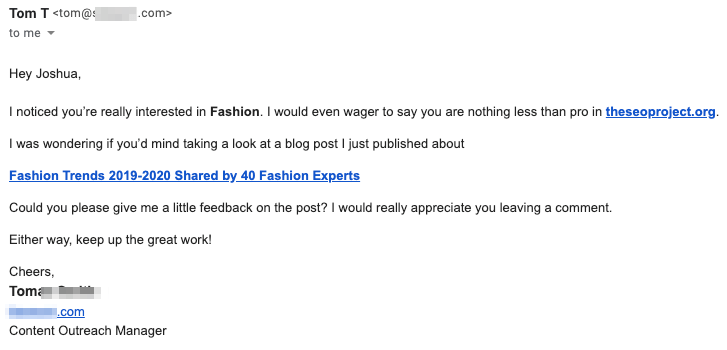
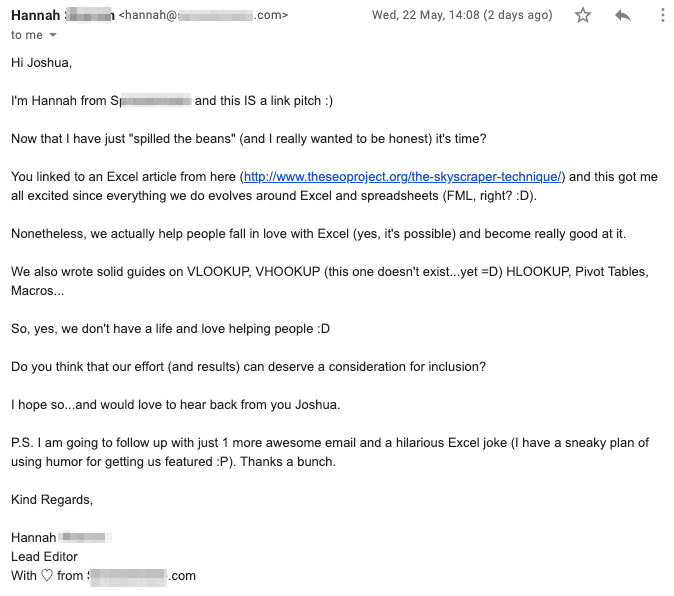
Leave your vote before you read any further. I’m curious to see the results.
…..
My verdict? The first email is spam; the second email isn’t.
It’s clear that both emails are templates, but only the second one makes any attempt whatsoever to be relevant, personable, charming, and engaging.
The first is literally just some guy broadcasting the fact that he’s written an article.
Which brings me to another point:
Outreach != broadcasting
Nobody wants to receive emails like that first example in their inbox. If they did, they’d sign up to your email list.
To assume otherwise is just plain disrespectful.
People aren’t stupid. They can spot a generic outreach template a mile off, and when they do, they’ll know three things about you:
- You’re selfish.
- You’re lazy.
- You don’t give a damn about them or their business.
Wow. What a great first impression. 🙄
But here’s the thing: nearly all outreach emails look like this, which can lead to two somewhat contradictory thoughts:
These outreach emails are terrible. Surely nobody ever replies to these things, right!?
These outreach emails are terrible. But everyone seems to be sending them, so they must work, right!?
Weirdly, both of those statements are kind of true…
There are two main trains of thought (approaches) in the world of blogger outreach:
- The sniper approach.
- The shotgun approach.
Let’s briefly cover what these are.
The sniper approach
Advocates of the sniper approach choose their “targets” carefully and send highly-personalized outreach emails to each of them.
They believe that effective outreach is all about giving some kind of value to a relatively small list of targeted prospects and expecting something positive in return.
This is the approach we use and advocate at Ahrefs.
The shotgun approach
Advocates of the shotgun approach send lots of outreach emails to a broader list of “targets” and spend little or no time personalizing those emails.
They believe that effective outreach is all about “scale”—more emails equals more links.
…..
The reason bad blogger outreach still exists is that so many opt for the shotgun approach.
It’s easy to see why, too:
- It takes less time.
- It requires less effort.
- It feels like you’re making tracks… even if you aren’t.
Now, in the interest of being totally honest and transparent, here’s the truth:
If you’re playing a short-term game, and couldn’t care less about burning bridges, the shotgun approach makes a lot of sense.
I mean, from a pure link building perspective, there’s no difference between sending 100 personalized emails and convincing 10% of them to link to you, and sending 1,000 non-personalized emails and convincing only 1% to link to you.
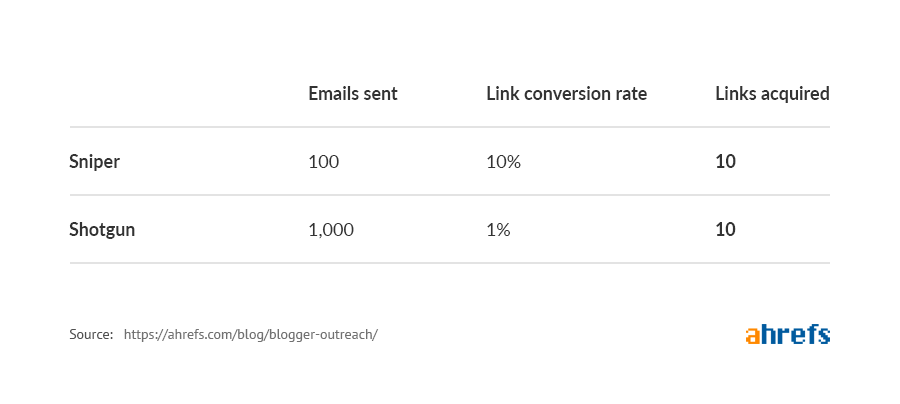
So, personal preference and contempt for spammy emails aside, why don’t we recommend the shotgun approach?
Three reasons:
- Link prospects aren’t infinite. No matter what niche you’re in, there are only a finite number of websites from which a backlink is likely to move the needle. If you burn through and alienate 99% of these prospects, the ceiling for your link building efforts is going to be pretty low.
- Deliverability issues. Have you ever seen that button in Gmail that marks emails as spam? The more people that click this, the less Google is going to trust your emails. And if that happens, your emails may end up in your recipients’ spam folders.
- Lower quality links. Because bad outreach is so prevalent, anyone with a half-decent website has likely received shotgun-style emails before. So, it’s probable that this approach is more likely to work on those with newer or weaker sites who don’t get so many bad pitches.
For those reasons, the process that I’m about to outline focuses on a sniper approach.
Many link building strategies rely on a specific way to find outreach prospects.
- Skyscraper technique = Websites that link to inferior articles.
- Resource page link building = Websites with relevant resource pages.
- Broken link building = Websites linking to relevant dead pages.
- Unlinked mentions = Websites that mention but don’t link to you.
Those tactics work well, but only in specific circumstances.
If you’re only pulling prospects within the confines of specific tactics, you’re leaving a lot of links on the table.
So here are four main ways to find more outreach prospects:
1. People who’re featured in your article
If you’re mentioning and linking to useful resources from other bloggers in your content, then why not reach out and let them know about the mention?
This one is easy enough to do.
Load up your blog post, then skim through looking for mentions of bloggers in your space.

If this sounds like too much work, you can speed up the process using a tool that extracts all external links from the page, like this one.
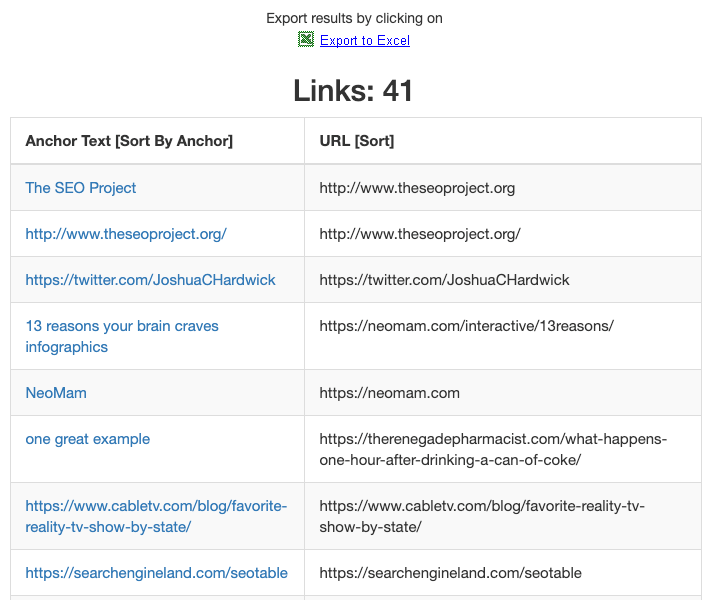
IMPORTANT! Make sure to choose “External” from the drop-down (there’s no point to extracting internal links) and uncheck the “Image” and “Meta tag” boxes.
Export the results to CSV, then sift through deleting any irrelevant prospects.
2. People who’ve written articles on the same topic
If someone has written an article about the same topic as you have, then you can bet that they’re pretty damn interested in that topic. That’s why I only write about SEO and not fashion—I couldn’t care less about fashion, and my wardrobe consists mainly of joggers and $2 t-shirts.
Here are two ways to find these people:
Use Google
Head over to Google and search for some keywords related to the topic of your content. Collect a list of articles that appear in the results.
If I were looking for prospects for this post, I’d search for something like “blogger outreach.”
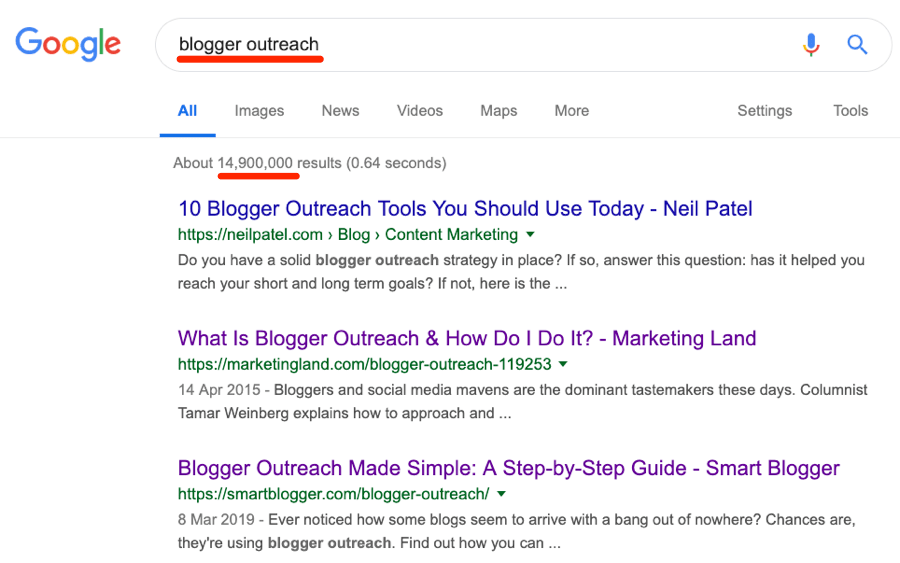
Because people are generally more likely to update newer posts that they still care about, you might also want to filter for and focus on “fresh” content. To do that, hit Tools > Any time > choose a recent date range.

Beyond that, you can also get creative with advanced Google search operators to find super-relevant and hyper-specific results.
For example, this article mentions the shotgun vs. sniper outreach approaches, so I could use search operators to find only posts about blogger outreach that don’t mention those two things.

That way, I’m already starting to build up an excuse for my outreach (“I saw that you wrote about blogger outreach but didn’t mention the shotgun vs. sniper approaches - my article mentions those…”)
But still, copy-pasting hundreds of URLs from Google search results can be quite tedious (unless you’re good with scrapers).
Luckily, you can speed this process up using Ahrefs’ SEO toolbar.
Just install the toolbar, then hit the download arrow to extract and export all search results on the page to a CSV.

Even better, the CSV includes all Ahrefs SEO metrics like Domain Rating, estimated organic traffic, and so on. (These will come in handy later).
Still too tedious? Keep reading.
Use Content Explorer
Content Explorer is a searchable and filterable database of over a BILLION web pages, from which you can export tens of thousands of results in just a couple of clicks.
If we search for blogger outreach, we get 6,026 results.

All these are instantly exportable to CSV.
But because Content Explorer searches for mentions of these keywords anywhere on the page by default, it often pays to get a bit more granular.
So let’s change the search type to “intitle,” put our term in quotes, and toggle the “One article per domain” button so that we don’t end up pitching the same sites more than once.

Now we’re down to 385 hyper-relevant results.
If your list is still too big, you might also want to use the “highlight unlinked domains” feature to find only websites that have never linked to you before:

These “unlinked” prospects should be given special care in your outreach emails because a link from them will bring more value than a link from someone who has already linked to you.
How do we know? Because we studied almost a billion webpages and found a clear correlation between the number of backlinks from unique websites (referring domains) and traffic:

Once you’re happy, hit export to download the results to CSV.
3. People who’ve linked to articles on the same topic
Head over to Content Explorer and search for something related to the topic of your article.
Then follow these two steps to identify the articles with the most backlinks:
- Set “Referring domains” to only show articles with at least 10 websites linking to them;
- Sort the results by referring domains (high to low)

From there, it’s just a matter of putting the URL of each article into Site Explorer and examining its backlinks one by one to see if there’s an opportunity for outreach.
This can be super tedious at first, but with some experience, you get very good at identifying the most promising outreach prospects just by looking at the title of the linking page and the text that surrounds a link.
You can also use the inbuilt filters to hone in on the best prospects.
This is one of my favorite filter combinations for speeding up this task:
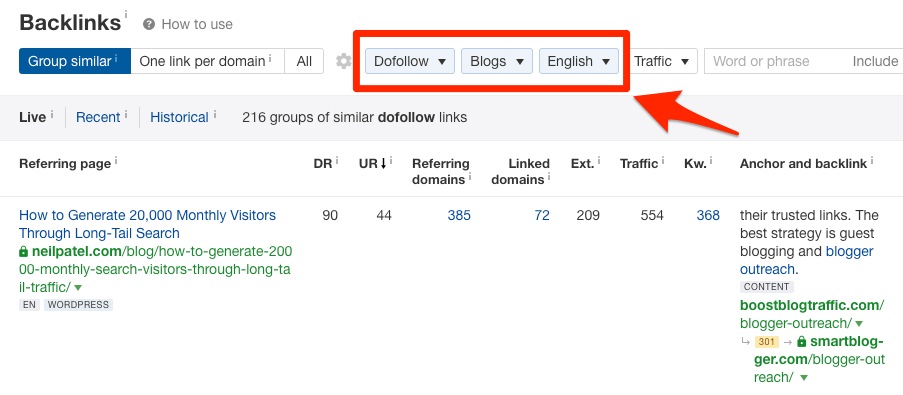
It’s also possible to use Google to find prospects, as I mentioned in the previous point.
You can then extract and export the SERP using the Ahrefs SEO toolbar, which will give you a spreadsheet that looks something like this:

Just sort by the Referring Domains column from high to low, then paste any relevant pages into Ahrefs Site Explorer one by one.
4. People who tweeted articles on the same topic
I listed the four groups of prospects in order of decreasing effectiveness.
So this group is the least effective of the three for two reasons:
Firstly, people tweet out a lot more content than they publish or link to. So unless you’re also planning to ask these people to tweet your article (which we don’t recommend), the chances of them linking to you is slim to none.
Secondly, people tweet a lot, and usually, they don’t even read what they share.
But that doesn’t mean that you should ignore this group of prospects altogether.
As with the other two groups, it’s just a matter of cherry-picking the best prospects to reach out to and investing some time to personalize your outreach.
Finding people who tweeted a particular piece of content is quite easy. Just plug the URL into a Twitter search:
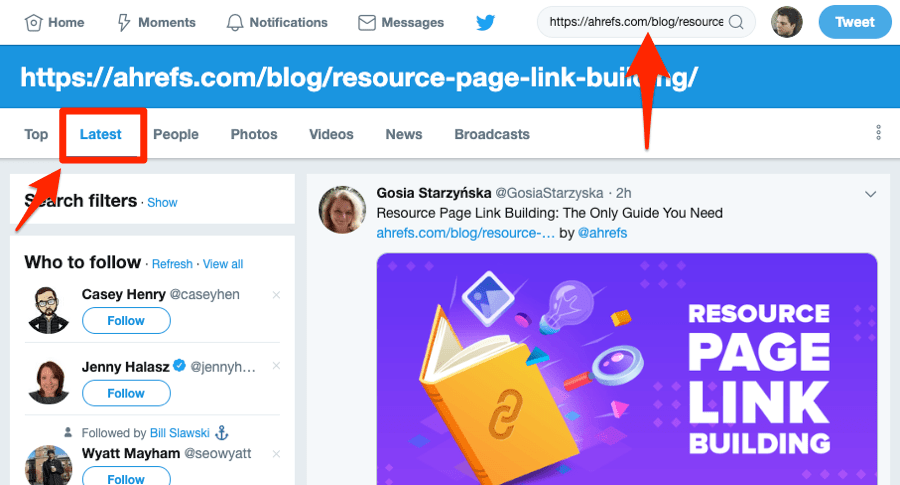
By default, Twitter will show you the “Top” tweets, which is very convenient for outreach prospecting. But you can also click on the “Latest” tab to see everything they’ve got.
The issue with this approach is that scraping the data you need from Twitter is a total nightmare.
Luckily, we have that data in Content Explorer—just paste in a URL and check the “Who tweeted” tab:

However, if you’re going to bother doing this at all, you should filter for recent tweets only.
Reason being, people are unlikely to remember what they tweeted last week, let alone a month or six months ago. If you hit people up with a “Hey, saw you tweeted x last December” in mid-August, then you’re going to look like a total stalker.
I recommend opting for “Last 24 hours” or “Last 7 days” at the most.

The only problem with this approach is that you’ll often end up with few or no results, which renders the whole activity somewhat pointless. So here’s a much better workflow:
- Search for a topic in Content Explorer;
- Filter for only articles published in the last 7-30 days and only “Published once”;
- Sort the results by Twitter shares.
Now you should have a list of relevant articles, with tweets, that are all recent.

Good outreach relies on not treating everyone the same.
That’s why you should divide your list of prospects into groups according to their level of “influence.”
Here’s are the four groups our CMO, Tim Soulo recommends—which generally work very well:
1. Sharks
These are the people with a huge audience and notable achievements.
In the marketing and entrepreneurial space, this would be people like:
- Gary Vaynerchuk
- Tim Ferriss
- Guy Kawasaki
- Seth Godin
How to get on their radar
These people don’t have time to read emails from strangers, so your only chance to reach them is by a personal introduction or by doing something really creative and outstanding.
Should you reach out to them?
No. It might seem enticing to pursue these prospects, but it’ll be too tough to get their attention.
2. Big Fish
These people are not as famous as the Sharks, but their audience is big enough to make an impact on your own business.
In marketing, Big Fish might be:
- Brian Dean
- Noah Kagan
- Glen Allsopp
- Robbie Richards
- Matthew Woodward
How to get on their radar
There’s a good chance to reach them with a nice personal email, but never with a generic template.
Asking Big Fish for tweets and links is unproductive (and silly). You will get much more value by asking them to critique your work or validate your ideas.
If what you’re doing is worth their attention, they will tweet and link to it anyway.
Should you reach out to them?
Yes. A link or tweet from these people can have a lot of value to your business.
3. Small fish
These people don’t have a big audience yet. Their websites are only just starting to get traction and they are actively promoting themselves by contributing to niche communities, writing guest posts and participating in all sorts of events.
How to get on their radar
These people usually respond to personalized, respectful, and value-adding outreach emails, even if they’re loosely template-based.
Should you reach out to them?
Yes. While a link or tweet from one of these people won’t bring as much value to your business as one from a Big fish, they’re usually more eager to build relationships.
4. Spawn
They are just starting out in your industry and have yet to build a substantial audience.
How to get on their radar
These people will often reply to your outreach emails even if they’re 100% templated.
Should you reach out to them?
No. As harsh as it sounds, a link or tweet from these people won’t offer much in the way of value.
…..
So, now we know who we should and shouldn’t reach out to, how do we segment the list of prospects we have?
Let’s start by filtering out the people we don’t want to contact: Sharks and Spawn.
There’s no totally foolproof way of doing this, but I’ve found that filtering by Domain Rating (DR) is the best way to do it at scale.
If you used Content Explorer (or the Ahrefs SEO toolbar + Google) to find and extract your initial list of prospects, the resulting CSV should have this metric for all the sites.

To filter out the Spawn, delete prospects with a DR lower than 20.
To filter out the Sharks, delete prospects with a DR higher than 80.
Don’t have the Domain Rating for your list of prospects?
Paste them into Ahrefs’ Batch Analysis tool in batches of up to 200 at a time.

From here, you should be left only with Big Fish and Small Fish.
To segment this resulting list, you can once again filter by DR.
As a general rule of thumb, I would class prospects with a DR equal to or above 50 as Big Fish, and those with a DR lower than 50 as Small Fish.
IMPORTANT! This is not an exact science. It’s up to you to choose how to segment your prospects.
To reiterate, the reason for doing this is because Big Fish are more valuable than Small fish, so it pays to spend more time and effort reaching out to those people.
Let’s face it: this is the real bottleneck when it comes to doing blogger outreach at scale.
Finding email addresses is tedious, time-consuming, and actually surprisingly tricky to automate—at least if you care about finding the right contact details.
Lots of people rely on some automated tools to scrape (or sometimes even guess) their outreach prospects’ email addresses instead of investing a bit of time to research each person and find their actual email.
For example, Tim’s email address is listed on our team page for everyone to see: [email protected].
But as Tim explains in his outreach guide, some people prefer to send emails to a non‐existent [email protected], which are picked up by our catchall:

He ignores these emails.
In his own words:
The fact that a person didn’t bother to find my real email tells me they’re not that interested in getting in touch with me. So I’m not interested in replying either.
I’m actually not going to go into much more detail about finding email addresses in this post because we already have a comprehensive guide showing eight ways to do that.
But what I am going to share is a nifty “hack” to speed up this process.
FYI, I’ve not seen anyone share this tip before.
The Hunter “Hack”
Hunter.io is a popular automated tool for finding the email addresses associated with a website.
For example, if you install their Chrome extension and hit it while browsing ahrefs.com, it’ll kick back the email addresses of a few people you might recognize.

That’s cool, but there’s a problem:
You often end up with a list of many people’s email addresses but have no clue to whom you should reach out.
The problem here is a flawed methodology.
Don’t start with a website, find the emails associated with it, then try to guess the best one. Instead, start with a name and website, then find that specific person’s email address.
Hunter has a tool for this:

Even better, they have a bulk version of this tool, meaning you can upload a list of names and websites and Hunter will try to find each person’s email address.
So now only one question remains: how do you find a list of names and websites?
Well, if your list of prospects came from Content Explorer, you may have noticed that we show author names for some of the results:

These appear in CSV exports too.

The only thing that’s missing is the raw domain. But you can pull that easily with this formula in Google Sheets: =REGEXEXTRACT(C2,"^(?:https?:\/\/)?(?:[^@\n]+@)?(?:www\.)?([^:\/\n]+)")

You can then filter the spreadsheet only for URLs with author names, and upload to Hunter’s bulk email finder tool.
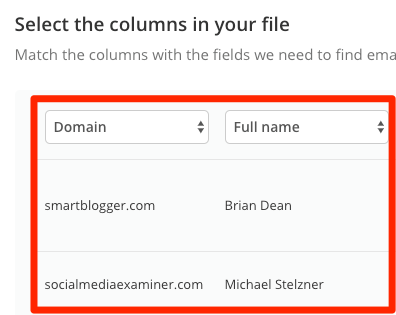
Of course, Hunter is never going to find emails for all the prospects, but it’s an excellent way to get a headstart.
You can use a virtual assistant to find the rest based on the process outlined here.
Always verify your emails before starting an outreach campaign.
If you fail to do this, bounces may affect the deliverability rate of your campaign.
There are lots of tools out there for verifying emails, but Neverbounce and Zerobounce are the two I’ve seen the most success with.
This is the point at which most outreach guides tell you to come up with a template for your campaign that looks something like this:
Hey %First_Name%,
I just came across your article: %URL_of_their_article%
Great stuff!
I noticed that you linked to this post: %URL_where_they_link_to%
It’s a great post, but I wrote an even better article on that same topic.
Check it out here: %URL_of_my_article%
I hope you can add a link to my post in your article or at least tweet it.
Thanks!
Now there’s nothing wrong with templates. You need them to succeed if you want to scale your outreach.
But the problem with starting with a templated approach is obvious:
You end up with something that looks and feels like a template… because it is.
So, for now, throw away your templates and instead, focus on crafting a winning pitch to just ONE person.
Here are some tips for doing that, a few of which come from this post:
1. Evoke curiosity with your subject line
Get your subject line wrong, and nobody is going to open your email, let alone read what you have to say or link to you.
That’s probably why 2,200 people search for “best email subject lines” every month in the US alone.

If you’re one of those people, please stop.
Most of the advice in articles about “best subject lines” is total garbage. Even if you don’t want to take my word on that, what do you think happens when 2,200 people read the same article, with the same subject lines, and proceed to use them?
That’s right, everyone ends up using the same subject lines, and nobody stands out.
Instead, try to write a subject line that describes the reason for your email and evokes curiosity.
Example:
Subject: Blogger outreach (5-step process)
You should also aim to keep your subject lines as short and sweet as possible. Otherwise, the email will get truncated in most email clients.
And whatever you do, try to avoid sounding sleazy, sales-ey and robotic.
Subject: Josh, Compliment On One Of Your Posts!
Subject: You’ve GOT to see this!
Subject: backlink request
If you’re struggling, just pretend its a regular email to a work colleague.
Why a colleague and not a friend? Because unfortunately, “lol” isn’t going to cut it as a subject line.
2. Show them you know them
Take the time to learn a little more about the person to whom you’re reaching out, and your response rate will go through the roof.
Here’s one of my favorite emails from a few years back:
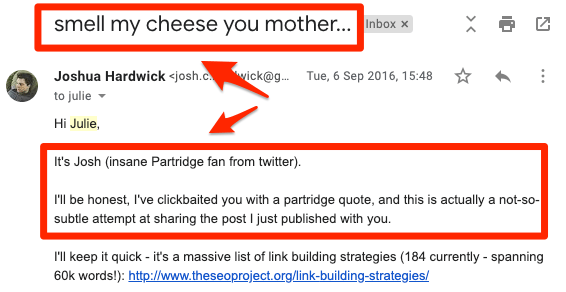
I sent this cold email I sent to Julie Joyce in 2016. I knew from brief exchanges on Twitter that Julie was a HUGE Alan Partridge fan, so I incorporated that fact into my email.
Was this extra effort worth it?
Definitely. Not only did Julie and I exchange many an Alan Partridge-related email…

… but she also mentioned the email in a column on SEL:

Julie linked to my website from that article too. Unfortunately, SEL stripped it. 🙁
Back to business…
I recommended showing the recipient that you know them in the first couple of lines of your email. Why? Because this part shows up before opening in most email clients…
![]()
… so it’s part of your first impression.
3. Avoid fake flattery
“Hey, I just read your article about %topic%. Great stuff!”
Yeah… I believe you. 🙄
Empty compliments like this are in nearly all outreach emails, and there’s just no need for them.
I mean, do you really think you’re fooling anyone with such a vague and clearly untrue statement? I doubt it.
Either say something meaningful or don’t say anything at all.
Here are some good examples:
I love what you said about XXX. I’m totally going to implement it this month.
Your story of XXX is totally inspiring. I’ve just shared it with a couple of my friends.
Still sound pretty generic? That’s because you need to fill in the “XXX” part with something personable and real.
Here’s an email I sent a couple of years ago with a 100% genuine compliment:

4. Explain why you’re contacting them
Here are the three most common outreach excuses:
You tweeted this post, and I wrote a similar one…
You published this post, and I wrote a similar one…
You linked to this post, and I wrote a similar one…
I’ll let Tim explain why these don’t make much sense:
Why would anyone want to check out a post that’s similar to what they just read? “Similar article” is a very poor excuse, as it shows you didn’t study the person you’re reaching out to.
I couldn’t agree more. So here’s what a decent reason might look like:
… I saw that you tweeted XXX the other day, so I thought you might appreciate reading a different opinion on that topic…
… I saw that you wrote this post but didn’t mention anything about XXX, which is an important topic I talk about in my post…
… I noticed you linked to this article when talking about XXX, but that’s actually no longer true. My post has more up-to-date…
Most people don’t say these kinds of things in their outreach emails because it takes more time. You have to research your prospects, skim their content, and come up with a genuine reason that might actually resonate with them.
Sounds like a lot of work, right?
It can be, but if you’re reaching out to people who linked to articles on the same topic, there’s a trick you can use to make this process faster.
It’s called: prospect bucketing.
Here’s how it works:
Instead of coming up with a 100% unique outreach excuse for every one of your prospects, you instead group prospects into “buckets” based on the reason they linked to that similar article.
Let me explain with an example.
Say that we want to promote our guide to long-tail keywords by reaching out to those who link to a similar guide. If we throw the URL of that competing guide into Ahrefs Site Explorer, then check the Backlinks report, it only takes a bit of skimming to see that quite a few of those people are linking to the guide for the same reason:


Basically, the article those people are linking to defines long-tail keywords as those that consist of three or more words. Our guide challenges that notion.
So, we could group anyone linking for that reason into one bucket, and reach out to each of them with something like this:
I’m reaching out because I saw you mentioned “long-tail keywords” in your post about {post topic}, where you describe them as keywords consisting of three words or more.
Here at Ahrefs, we believe that this definition of the term “long tail keywords” needs revisiting for 2019, as well as the actual strategy of getting traffic from them. So we wrote an article explaining our thoughts. (Hint: It’s more about search volume than the number of words).
Here’s the link: https://ahrefs.com/blog/long-tail-keywords/
Hopefully, you agree that this is a much more compelling “why” than “… I wrote a similar article.”
5. End with a clear call-to-action
No, this doesn’t mean ending your outreach emails with something like this:
Can you please add my link to your article?
Is there any way I can get a link?
I won’t lie: there are times when asking for a link in your first email makes sense. But most of the time, it’s not appropriate. It’s kind of like proposing on a first date—the answer will almost certainly be a swift “no.”
If not asking for a link in your first email sounds crazy to you, then you’re viewing this all wrong.
The aim of your first email isn’t to close the deal, but rather to start a conversation.
So you want to end with something that prompts the recipient to reply.
Here are some ideas:
Is there anything I missed?
What do you think?
Do you agree with our conclusion?
I’ll level with you, those are still quite generic, which is why it’s important to craft a unique outreach email not only for each campaign but also for each segment of prospects.
6. Only use your best work
Most people publish new content all the time. For example, we publish 1-2 new blog posts per week on the Ahrefs blog, and we now have more than 150 posts in total.
Do you really think it makes sense to do outreach for all of those posts?
Absolutely not. If we did, we’d soon start to annoy other bloggers in our industry and burn bridges.
That’s why we only do outreach for the very best ones.
The problem is that “best” is subjective, so how do you choose which posts to perform outreach for, and which not to perform outreach for?
Simple. Paste your website into Ahrefs Site Explorer, then check the “Top content” report.
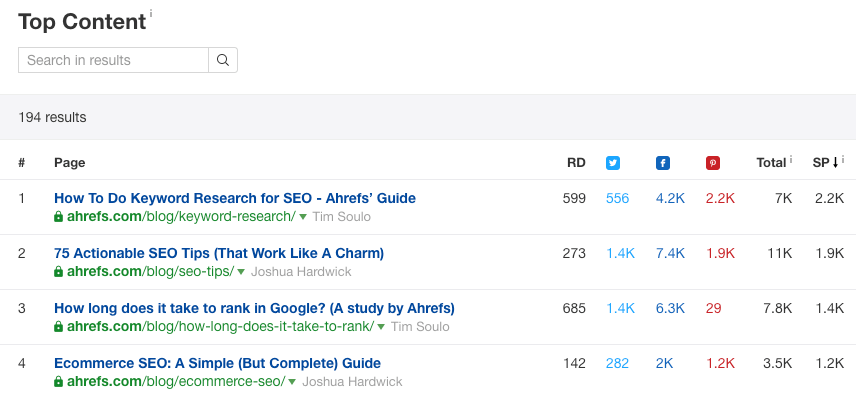
This report ranks the content on your website by “social power”—i.e., the total number of social shares they’ve generated across all social networks currently tracked by Ahrefs.
Bonus tip: Use these stats as social proof in your outreach emails.
…..
If that all sounds quite basic, it’s because it is. Outreach isn’t rocket science, and it’s not about using clever psychology or tricks to try to get what you want. It’s about treating people like human beings and letting your content do the talking.
The best way to think of it is like this:
- You’re contacting this person because you know they’re interested in a certain topic.
- You think they might find value in your content.
- Sending this email just so happens to be the quickest and most direct way to introduce them to that content.
Here’s what most people do at this stage:
- Load up their pitch in an outreach tool like Pitchbox.
- Replace the first name using a mail-merge field.
- Upload their list of prospects.
- Blast out thousands of “personalized” emails.
Um, no. This isn’t personalization.
Personalization is tailoring the conversation for every recipient. And let me tell you, personalization and “success rate” are closely correlated.
But the question is, how do you take that winning pitch you just crafted and personalize it, at scale, for hundreds of recipients? I mean, if you went the whole hog in the last step, some parts of your pitch are likely so “personalized” that you can literally only send it to ONE recipient, right?
Don’t panic. That was the whole point. 🙂
Like I said earlier, if you set out to create a template, that’s precisely what you end up with—something super generic that reads like a template.
By doing things this way, you can templatize a winning pitch instead of trying to make your robotic template sound personal and unique. That works much better in my experience.
How do you templatize it?
Using merge fields.
1. Create some custom merge fields
Having followed my own advice in steps 1-4, I crafted this email to send to someone who’s written a similar post about blogger outreach:
Hey Paul,
Just been reading your post on blogger outreach. LOVE that tip about using IFTTT then to create a database of Twitter interactions. 100% Genius. Going to set that up for myself this weekend.
I’m emailing you because I actually just published my own guide to blogger outreach, and it mentions a couple of things I didn’t see you mention (e.g., the difference between a shotgun vs. sniper approach).
Here’s the link: https://ahrefs.com/blog/blogger-outreach/
If you have a second, I’d love to get your feedback.
Cheers,
Josh
Looks pretty personalized, right?
So the next step is to replace any personalized parts of the email with custom merge fields.
By that, I mean chunks of the email that can be altered and adjusted for each recipient to effectively templatize this email, without losing any of the personalization.
Here’s that same email again with the merge fields added in:
Hey %first_name%,
Just been reading your post on blogger outreach: LOVE that tip about %nugget_of_wisdom%.
I’m emailing you because I actually just published my own guide to blogger outreach, and it mentions a couple of things I didn’t see you mention (e.g., %something_they_didn’t_mention%).
Here’s the link: https://ahrefs.com/blog/blogger-outreach/
If you have a second, I’d love to get your feedback.
Cheers,
Josh
You can see that some of these are basic data points: %first_name%, %URL%, etc.
But some are more contextual, e.g., %nugget_of_wisdom%.
2. Fill in your merge fields
Before you can send any of these emails, you need to actually decide what these merge tags will be replaced with for each prospect.
The best way to do that, in my opinion, is in a spreadsheet.
So, open up a blank sheet and give is a name. Something like “Post name - Prospect type - Segment” will suffice.
Next, add each of your custom merge fields as column headers.
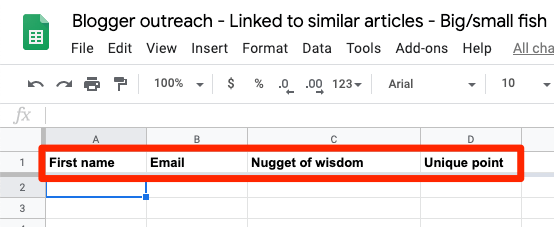
IMPORTANT! You also need to create a column for their email addresses, which you should have already found in step #3.
From here, add in your prospects and start filling in the columns.
Just make sure to consider the context of your email when filling them. It needs to make sense and read naturally once you bring these two things together.
You should end up with something like this:

Of course, this is where the segmentation you did earlier comes in handy, because you can spend more time personalizing emails meant for Big fish over Small fish.
It’s perfectly fine to shun merge tags altogether and instead fill these parts in on the fly when sending emails. The reason I prefer a spreadsheet approach is that it’s much easier to outsource.
For example, we could easily hire a freelancer to find the following data points for each of our prospects:
- Unique nugget of wisdom from their post
- Something our post mentions that theirs doesn’t
Not only does this reduce your workload, but it’s also often more cost efficient.
3. Review and send
Here’s where everything starts to come together because now, all that’s left to do is to upload your spreadsheet to your outreach software along with your template.
It will then replace those merge fields in the template with the data points in your sheet.
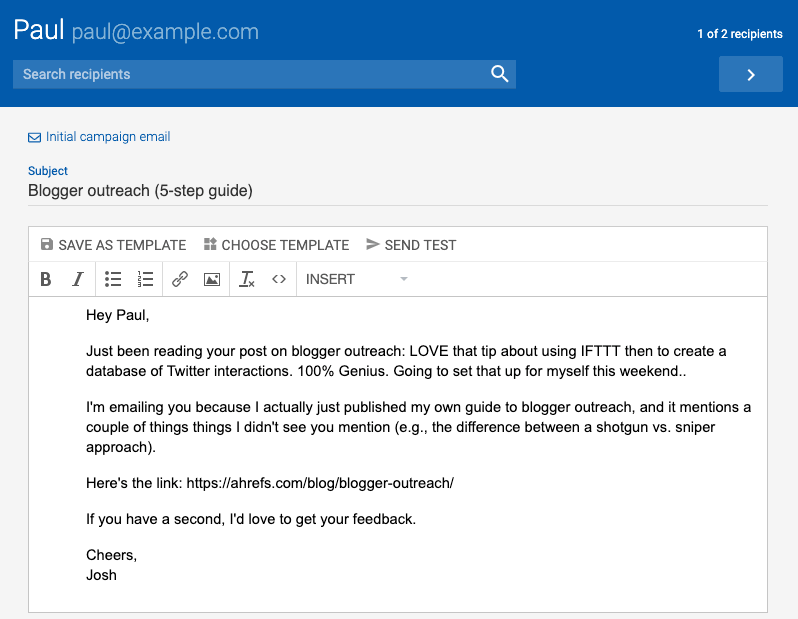
You now have hundreds of emails ready to go.
Just make sure to skim each email to make sure everything makes sense before hitting send.
Seriously, don’t neglect that last step and be tempted to hit send. It takes a lot of work to get to this point, and outreach faux pas are all too common. Believe me.
4. Follow-up, once!
Read any half-decent article about blogger outreach, and it’ll say the same thing:
Most of your replies and links will come from follow-ups.
That’s true, but at the same time, you don’t want to pester people with constant follow-ups. So the solution, in our opinion, is to follow-up once and only once.
Something polite and straightforward works well:
Hey %name%,
Just a quick follow up in case you’ve missed my email.
If you’re short on time right now—no worries. I won’t bug you about it again.
Thanks.
That’s it.
Please don’t send more follow ups. You’ll only annoy people and burn bridges.
The fact that you’ve read this far means that you now know more about outreach than 99.9% of so-called link building experts. Nice work! Great stuff! 😉
But there’s still a problem, and it’s the fact that every campaign comes to an end eventually. Or does it?
What if there was a way to continually find new outreach prospects for your campaigns?
Good news: there is—a few ways, actually.
1. Mentions of relevant keywords
SEOs and marketers have been using tools like Google Alerts for years.
Not familiar with such tools? All you do is enter a few keywords related to your piece of content, and you’ll be notified whenever someone mentions these keywords online.
Depending on the context of that keyword mention, you then decide if it makes sense to reach out to the author of that article and show them your content.
Since Ahrefs has the second-best web crawler after Google (according to a third‐party study), we’ve developed our own web alerts functionality.
To add a mentions alert, go to Alerts > Mentions > + New alert

2. New links to relevant articles
Here’s a fun observation: Put the URL of any almost article that ranks #1 in Google into Ahrefs’ Site Explorer, and you’ll see that it consistently gets new backlinks:

Far too often, people settle for whatever is the #1 result in Google, and they rarely do any additional research. So, whenever they need to reference a resource on that topic, they give that top-ranking article yet another link.
We call this the “vicious circle of SEO.”
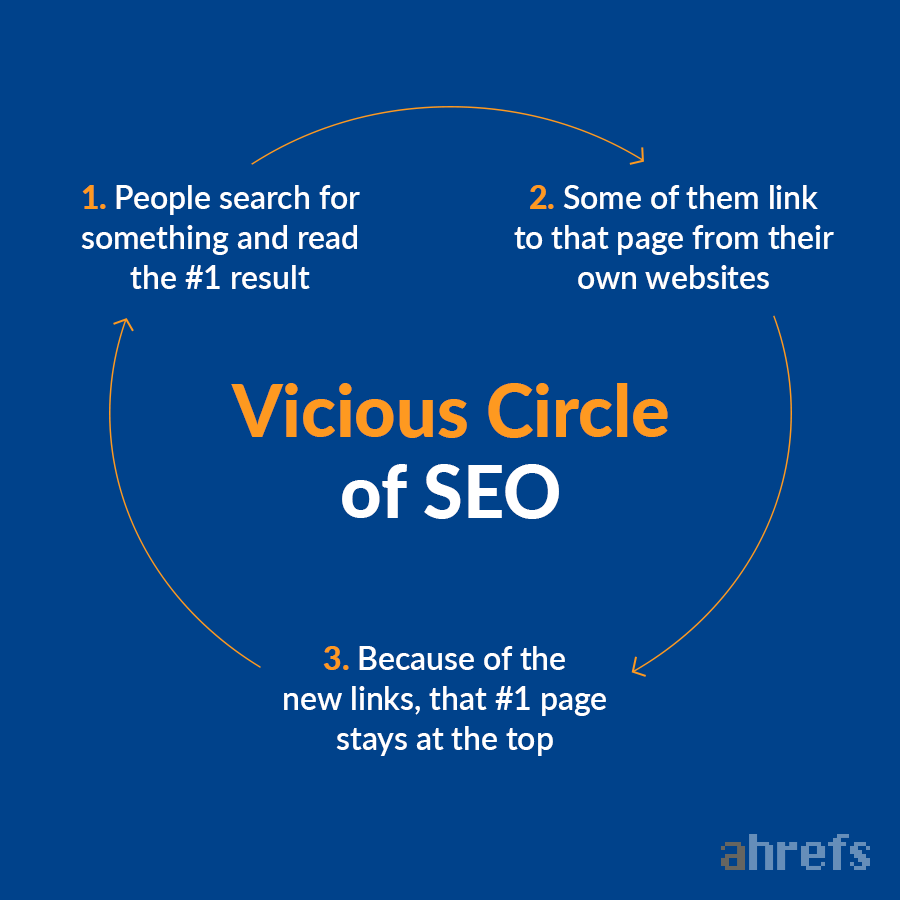
Your job is to use the vicious circle of SEO to your advantage by monitoring any new links to the top-ranking pages for your target keywords.
For this, you can use the backlink alerts functionality in Ahrefs Alerts.
Just enter the URL of any article you’d like to keep an eye on, and you will get an email notification whenever they get a new link:

3. New tweets of similar articles
Millions of new tweets go live every day, and some of them almost certainly link to articles about something similar to yours.
Yes, it may only be a few people, but that’s all you need.
Take a look at the number of tweets linking to this post about blogger outreach, for example:

Looks like there have been 280 in the past ~3 years.
Do the math, and that comes out to roughly one tweet every four days.
If we could somehow monitor tweets about that one article, we’d have a new potential outreach prospect every four days, on average.
If we did the same for a few other articles, we could easily end up with 50-100 new prospects every month.
But how do you monitor tweets?
Use the “New tweet from search” function for Twitter on IFTTT.
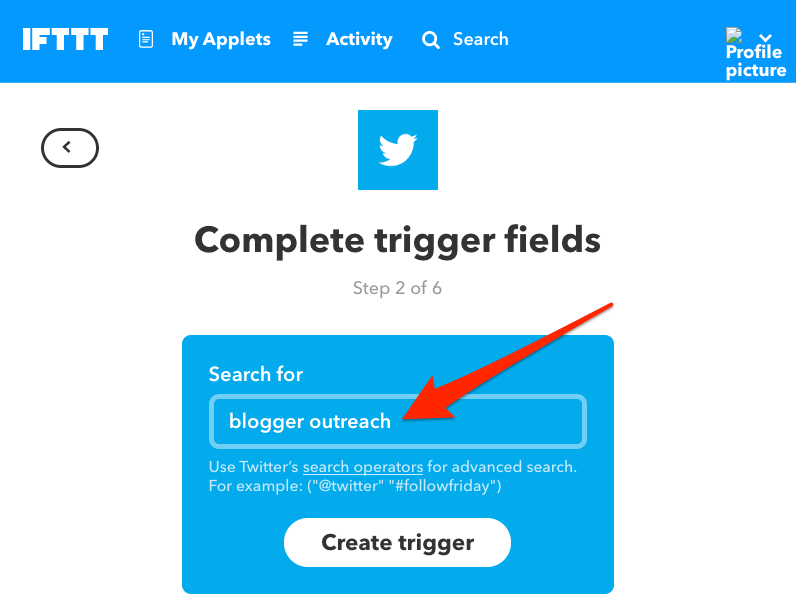
Before I wrap this up…
… I want to talk very briefly about outreach tricks.
People are obsessed with outreach tricks.
By “tricks,” I’m referring to small changes that they think will take their outreach campaign from zero to hero.
Here’s one of the latest ones I’ve seen:

You end all your emails with “Sent from my iPhone” to trick people into thinking that the email was, well, sent from your iPhone. In which case, this email can’t be spam, right?
*facepalm*
I’ve got news for you.
If your email looks like spam…
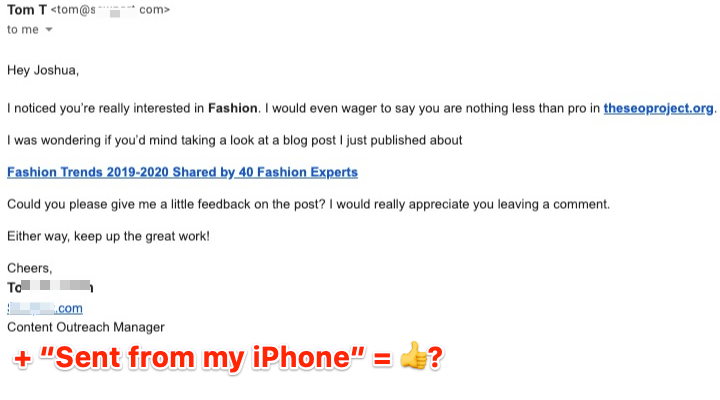
… then there ain’t no outreach “trick” in the world that’s going to save you.
Furthermore, people aren’t as dumb as most link builders think they are. Many outreach tricks are quite obvious and serve only to increase the blatant scumminess of your emails.
Now, does that mean that no outreach tricks work?
No. It just means that they’re not likely to rescue a failing outreach campaign because the reason it’s failing is always going to be bigger.
Having said that, there is one “trick” that will improve your results:
The importance of timing
Here at Ahrefs, our marketing team spends the vast majority of time working with the “new” blogger outreach prospects rather than sifting through the thousands of old ones.
If a person wrote/linked/tweeted something a year ago, it is unlikely that they are still interested in that same topic today. Therefore, our most sophisticated outreach email will seem “spammy”—simply because the timing isn’t right.
But once a brand new opportunity lands in our inbox, we want to react as soon as possible.
The topic is still fresh on the author’s mind, so they are usually still open to discussion.
Of course, we don’t completely ignore “old” prospects. We’re just very picky about who we decide to contact and ruthlessly filter out prospects that don’t look promising.
Final thoughts
Blogger outreach isn’t rocket science.
It may seem like it given the length of this article, but once you get the hang of things, everything usually fits into place rather quickly.
That’s not to say it’s always easy because it isn’t!
To truly succeed with outreach, you need to be a highly organized person, a good problem solver and above all, a people person.
Not all of those things? Don’t worry, most of us aren’t. The trick is to outsource each part of the process to people who excel at each aspect.
Do that, and you’ve got a system for all the links you’ll ever need.
Let me know in the comments or on Twitter if I missed anything. 🙂





